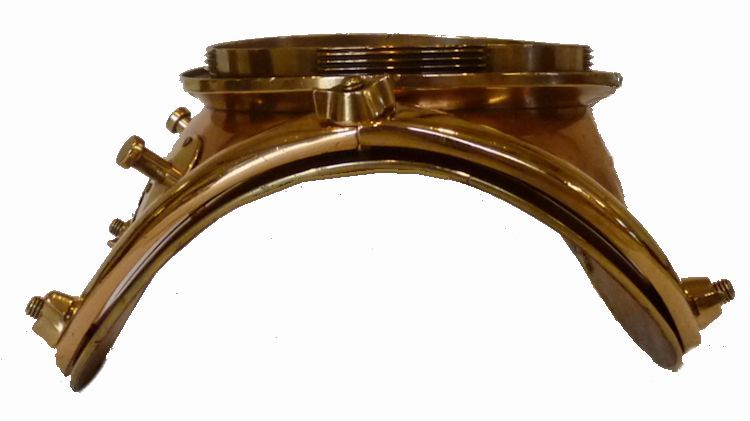SIEBE GORMAN
ROYAL NAVY
6 BOLT BREAST PLATE Ca 1934

NO STAND!
In 1840, August Siebe invented
the deep sea diving helmet as we know it today. A single Royal Navy Admiralty pattern breast plate without
the bonnet is a unique offering!SERIAL NUMBER 8366
WEIGHT BREAST PLATE 19 lbs
DIMENSIONS: 7 3/4“ H x 14“ W X 14 1/2“ D
DIAMETER OF NECK RING 8 15/16 inches
Copyright 2016 by Land And Sea Collection™, All
Rights Reserved
Presented is a Royal Navy
Admiralty Pattern 6 bolt breast plate, sometimes called a corselet, with the low serial number of 8366 on the inside
neck ring. In 2007, we sold a Siebe Gorman 6 bolt helmet that had a beast plate stamped 9529 which was dated to 1935 and is
a bench mark for this one. The recent one was discovered in Pretoria, South Africa, where it has been handed down
in a family for at least the last 40 to 50 years. It had a very ugly look so we had it polished and lacquered for display.
There was a bonnet with this helmet, but it was stolen in a burglary years ago which may account for some minor damage.
The neck ring on the horizontal plane is bent which can be seen in some of the pictures. We do not have anyway of testing
whether a bonnet will fit and have priced the item taking this into consideration. The maker’s tag is badly worn from
the weight that was hung from the two horns. An authentic, unused vintage plate is available that will only be sold
with this item as an optional addition.
|
|
|
Like all used diving gear,
this is being sold for DISPLAY ONLY. It should not be dived without having passed inspection by a certified dive shop.
this is being sold for DISPLAY ONLY. It should not be dived without having passed inspection by a certified dive shop.
MARKINGS: The heavily
worn maker’s tag, reads with difficulty, Siebe Gorman & Co. Ltd., Submarine Engineers, London,
Patent. The front brail is marked, “Patent” “Front” “Patent” and underneath is
marked 66. The rear brail is marked, “Back” in the center. The nut on the right rear
is stuck so the rear brail has not been removed.
Authentic Vintage tag
BRIEF HISTORY: Augustus Siebe the German-born founder of the firm which bears his name (1788-1872) is
considered “the father of diving”. Siebe’s ‘closed’ diving helmet, first produced in
1840, allowed divers to dive safely to greater depths than ever before. Attached to a rubber suit, it became the ‘Standard
Dress’ that revolutionized diving and made the underwater worker an essential part of both salvage operations and civil
engineering. Many of the great building projects of the Victorian era – bridges, tunnels and lighthouses still in use today
– could not have been built without divers.
Siebe’s design
was so successful that it remained in use, essentially unchanged, until 1975. However, the Royal Navy required one of their
own design, and the British Admiralty requested a helmet made to their specifications which used heavier materials
in 1938. This was the Royal Navy six bolt helmet, as seen in this offering. The rest of the “Jake” was standard
commercial equipment, except for the front weight which had a light fitted to it, to aid the diver. The chest weights
weigh about 40lbs. each and are tied down to stop the helmet rising from the diver’s shoulders. The weights are hung
from weight hangers on the front of the breast plate.
The
Royal Navy set out to extend the limits of deep diving and established
a world depth record, in 1948, of 540-feet wearing a Siebe Gorman helmet of this design, but incorporating a
Davis Injector system, flexible dress, and used the fast dwindling supplies of American Lend-Lease
helium. Petty-Officer Bollard set the depth record that was to last eight years. Not until 1956 would the baton pass
to another.
In October of that year, Senior Commissioned Boatswain George Wookey, descended to a depth of 600-feet,
setting record for a helmeted diver wearing flexible dress that still stands.
 >
>




